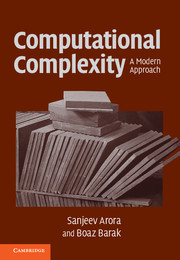Book contents
- Frontmatter
- Contents
- About this book
- Acknowledgments
- Introduction
- 0 Notational conventions
- PART ONE BASIC COMPLEXITY CLASSES
- PART TWO LOWER BOUNDS FOR CONCRETE COMPUTATIONAL MODELS
- PART THREE ADVANCED TOPICS
- Appendix: Mathematical background
- Hints and selected exercises
- Main theorems and definitions
- Bibliography
- Index
- Complexity class index
Appendix: Mathematical background
Published online by Cambridge University Press: 05 June 2012
- Frontmatter
- Contents
- About this book
- Acknowledgments
- Introduction
- 0 Notational conventions
- PART ONE BASIC COMPLEXITY CLASSES
- PART TWO LOWER BOUNDS FOR CONCRETE COMPUTATIONAL MODELS
- PART THREE ADVANCED TOPICS
- Appendix: Mathematical background
- Hints and selected exercises
- Main theorems and definitions
- Bibliography
- Index
- Complexity class index
Summary
This appendix reviews the mathematical notions used in this book. However, most of these are only used in few places, and so the reader might want to only quickly review Sections A.1 and A.2, and come back to the other sections as needed. In particular, apart from probability, the first part of the book essentially requires only comfort with mathematical proofs and some very basic notions of discrete math.
The topics described in this appendix are covered in greater depth in many texts and online sources. Almost all of the mathematical background needed is covered in a good undergraduate “discrete math for computer science” course as currently taught at many computer science departments. Some good sources for this material are the lecture notes by Papadimitriou and Vazirani [PV06], and the book by Rosen [Ros06].
The mathematical tool we use most often is discrete probability. Alon and Spencer [AS00b] is a great resource in this area. Also, the books of Mitzenmacher and Upfal [MU05] and Motwani and Raghavan [MR95] cover probability from a more algorithmic perspective.
Although knowledge of algorithms is not strictly necessary for this book, it would be quite useful. It would be helpful to review either one of the two recent books by Dasgupta et al. [DPV06] and Kleinberg and Tardos [KT06] or the earlier text by Cormen et al. [CLRS01]. This book does not require prior knowledge of computability and automata theory, but some basic familiarity with that theory could be useful: See Sipser's book [Sip96] for an excellent introduction.
- Type
- Chapter
- Information
- Computational ComplexityA Modern Approach, pp. 508 - 530Publisher: Cambridge University PressPrint publication year: 2009

